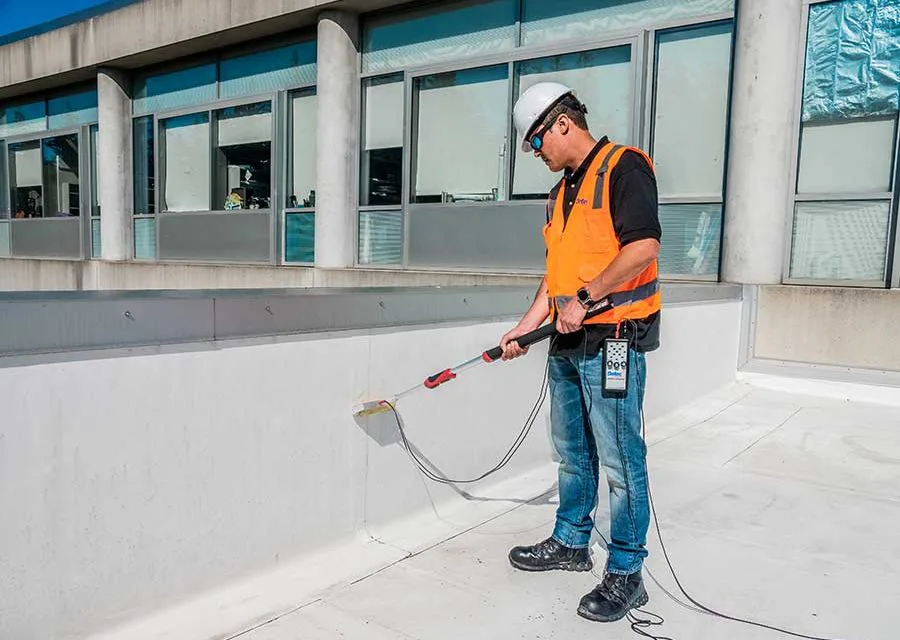The 6 Benefits of Meshless Membrane Testing
Every year, building owners, development teams, and their insurers spend hundreds of millions of dollars litigating and repairing water intrusion problems. The collateral damages include thousands of tons of wasted building materials, increases in insurance rates, non-renewal of policies, lost productivity, and injured reputations. The vast majority of these problems result from water intrusions that cause moisture to accumulate in the concealed spaces of buildings.
The failure to detect, identify, and correct minor water intrusions at the earliest stages is considered the greatest cause of premature roof failure.
This is particularly true of roofing materials applied on low-slope or flat roofs. Costly roofing problems are often the result of design deficiencies, faulty installation, or damage from other trades after installation. Even when properly designed and installed, roofing materials deteriorate from exposure. Roof designs that incorporate a waterproofing membrane under a green roof or other overburden greatly exacerbate the problem of locating leaks.
Unchecked moisture accumulation will reduce the structural integrity of buildings by creating rot in wood and corrosion in steel. Moisture can affect the health of occupants directly by breeding harmful organisms such as mould spores. Moisture can reduce the service life of the building structure and sensitive electronics through premature degradation of components. In short, uncontrolled moisture will negate the most vital and important qualities of a building.

Meshless membrane testing is a method used in the building industry to evaluate the performance and durability of building materials, specifically membranes, without the need for traditional physical testing methods that involve mesh reinforcement.
Here are some ways in which meshless membrane testing helps the building industry:
1. Cost-effective:
Meshless membrane testing eliminates the need for expensive mesh reinforcement materials and reduces the overall cost of testing. This allows building professionals to conduct more tests within their budget and make informed decisions regarding material selection.
2. Versatile material application:
Meshless membranes can be used in a variety of building applications such as roofing, waterproofing, and air barrier systems. By using meshless membranes, builders have greater flexibility in material selection, ensuring the best fit for their specific project requirements.
3. Improved durability and performance:
Mesh reinforcement in membranes can be a potential weak point, leading to reduced durability and performance. Meshless membranes, on the other hand, do not rely on mesh reinforcement, resulting in improved resistance to tearing, cracking, and degradation over time.
4. Accurate testing:
Meshless membrane testing utilizes advanced technology to provide valuable insights for design and construction purposes.
5. Time-efficient:
Meshless membrane testing is typically quicker than traditional physical testing methods, as it eliminates the need for mesh installation and removal procedures. This saves time during both the testing process and overall project timeline.
6. Enhanced design possibilities:
Meshless membrane testing enables designers to explore new and innovative architectural designs that may not be feasible with traditional mesh-reinforced membranes. This opens up possibilities for more creative and visually appealing building designs.
In summary, meshless membrane testing offers several benefits to the building industry, including cost-effectiveness, versatility, improved durability, accurate testing, time efficiency, and enhanced design possibilities. By utilizing this testing method, builders can make informed decisions about material selection, ensuring the long-term performance and sustainability of their structures.
How Does Detec System Works?
The principle of this Electronic Leak Detection (ELD) method is to establish a voltage potential between the membrane and the roof deck and then track any leakage current. This is accomplished by wetting the surface of the membrane, applying a voltage with respect to ground and then locating areas where electrical current flows through membrane breaches to the deck.
A scanning platform is used to test the membrane for breaches. The platform is constructed with dual metal sweeps which make continuous electrical contact with the membrane surface. The outer sweep forms a continuous perimeter around the platform with the inner sweep contained within the perimeter of the outer sweep.
The positive terminal of the unit is attached to the building electrical ground or the roof deck (concrete, metal, or any conductive material) and the negative terminals on the unit are attached to the sweeper sensors of the unit via the inner and outer sweep meters. The electrical signal from the outer sweep loop provides an electrical path over the wet area of the roof to any breach within the wetted area, thus completing the circuit to the ground wire.
A light spray of water is applied to the membrane in front of the advancing IntegriScan™ platform. The outer sweep responds to and displays any leakage current in the test area. The inner sweep will detect a maximum leakage current when the platform is directly over the membrane defect. This will result in a maximum indication on the inner sweep meter accompanied by an audible alert. This precisely identifies the place where water is penetrating through a breach in the membrane.
The IntegriScan™ is the only ELD method available to test conductive membranes, including black EPDM.

Detec Systems, serving the building industry since 2003, develops and provides leading-edge technology in the field of Electronic Leak Detection (ELD) internationally.
If you require our services for your upcoming projects, please do not hesitate to contact us.

